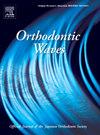用颈椎尺寸定量测定骨骼年龄
IF 0.5
Q4 DENTISTRY, ORAL SURGERY & MEDICINE
引用次数: 0
摘要
摘要:目的本研究旨在比较伊朗人群中使用第三和第四颈椎尺寸(cvd)与颈椎成熟度(CVM)方法测定骨骼年龄的差异。材料和方法本横断面研究对240例患者的侧位头颅x线片进行评价。根据CVM分期将样本分为下颌生长期峰前组(1组)、下颌生长期峰后组(2组)和下颌生长期峰后组(3组),各80例。测量第三和第四颈椎的尺寸。前椎体高度(AH)除以前后椎体长度(AP)。计算C3和C4的AH:AP比值的总和,并作为SV报告。研究了240例CVM患者SVs与CVM分期的相关性。p值小于0.05有统计学意义。结果SVs与CVM组有显著相关性(P < 0.05)。曲线下面积(AUC)对组1和组2的鉴别性较高(AUC = 0.9776;95% CI = 0.9448-0.9960),组2也来自组3 (AUC = 0.9848;95% ci = 0.9539-0.9984)。约登指数分别以1.29和1.61的SVs作为区分第1组和第2组、第2组和第3组的最佳分界点。结论所确定的两个分界点具有较高的灵敏度和特异性。因此,我们可以使用CVD来确定患者的下颌生长状况。本文章由计算机程序翻译,如有差异,请以英文原文为准。
Quantitative determination of skeletal age using cervical vertebral dimensions
ABSTRACT Purpose This study aimed to compare skeletal age determination by using the ratio of third and fourth cervical vertebral dimensions (CVDs) versus the cervical vertebral maturation (CVM) method in an Iranian population. Materials and methods Lateral cephalometric radiographs of 240 patients were evaluated in this cross sectional study. The samples were classified into three groups (n = 80) of pre-peak of mandibular growth period (group 1), peak of mandibular growth period (group 2), and post-peak of mandibular growth period (group 3) according to the CVM stage. The dimensions of the third and fourth cervical vertebrae were measured. The anterior vertebral body height (AH) was divided by the anteroposterior vertebral body length (AP). The summation of the AH:AP ratio of C3 and C4 was calculated and reported as the SV. The correlation of SVs of 240 patients with their CVM stage was investigated. P-value less than 0.05 is statistically significant. Results SVs had a significant correlation with the CVM groups (P < 0.05). The area under the curve (AUC) was high for discrimination of group 1 from group 2 (AUC = 0.9776; 95% CI = 0.9448–0.9960), and also group 2 from group 3 (AUC = 0.9848; 95% CI = 0.9539–0.9984). The Youden index specified SVs of 1.29 and 1.61 as the best cut-off points for discriminating group 1 from group 2, and group 2 from group 3, respectively. Conclusions The two determined cut-off points could discriminate the groups with high sensitivity and specificity. Accordingly, we can use the CVD to determine the patients’ mandibular growth status.
求助全文
通过发布文献求助,成功后即可免费获取论文全文。
去求助
来源期刊

Orthodontic Waves
DENTISTRY, ORAL SURGERY & MEDICINE-
CiteScore
0.40
自引率
0.00%
发文量
0
期刊介绍:
Orthodontic Waves is the official publication of the Japanese Orthodontic Society. The aim of this journal is to foster the advancement of orthodontic research and practice. The journal seeks to publish original articles (i) definitive reports of wide interest to the orthodontic community, (ii) Case Reports and (iii) Short Communications. Research papers stand on the scientific basis of orthodontics. Clinical topics covered include all techniques and approaches to treatment planning. All submissions are subject to peer review.
 求助内容:
求助内容: 应助结果提醒方式:
应助结果提醒方式:


